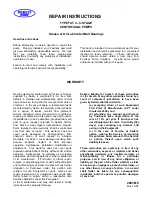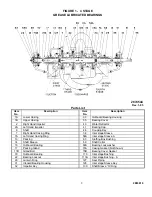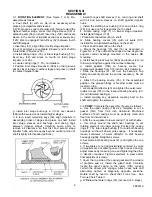
TABLE 1
BEARING DEFECTS
(Failures – Replace if found)
DEFECT (Failure)
Flaking and cracking
APPEARANCE
In the early stages, the surface of the inner and
outer races develop small cracks, which flake.
The cracks and flaking ultimately spread over
the entire race surface.
PROBABLE CAUSE
1.
Normal fatigue failure.
2.
Bearing loads in excess of bearing capacity
caused by misalignment.
Indentations
Indentations or cavities in the inner and outer
races.
1.
Dirt in the bearings.
2. Excessive impact loading of the bearings
such as improper mounting or removal.
Broken separator (cage)
Cracked separator or separator in pieces.
1.
Poor Lubrication.
2.
Misalignment of shaft.
3. Excessive
shaft
deflection.
Wear
Bore and OD of outer ring of bearing galled or
braided.
1.
Fit on shaft or in housing too loose.
2. Bearing locked by dirt and turning on shaft
or in housing.
Fractured ring
Hairline cracks or complete ring fracture.
1.
Forcing a cocked bearing on or off a shaft.
2.
Too heavy a press fit.
Discoloration
Rolling elements and races darker than normal
appearance of bearing metal.(Moderate
discoloration of rolling elements and races not
a reason for discard.)
1. Inadequate lubrication.
Corrosion
Rolling elements and raceways rusted.
1.
Water entering the housing.
2.
Condensation inside the housing.
3.
Lubricant breaks down into acid. (Wrong
lubricant.
pump) and push the bushings (63) to the rear of the stuffing
boxes. Insert the same number of packing rings as were
found during disassembly, on each side of the lantern ring
Insert each ring separately and stagger the joints of
successive rings 90 degrees. Insert the glands (17) and set
the nuts finger tight – DO NOT USE A WRENCH.
h. Rotate shaft by hand to check that it runs free.
i. Replace all drain plugs removed during disassembly.
3-3. Reinstall plumbing (if used) for water-cooled bearings.
a. Re-lubricated the bearings. Refer to Bulletin No. 2880549
for grease type recommendation.
It is most important to provide proper lubrication and keep
bearings clean. Frequency of lubrication must be determined
by experience as it depends upon bearing size, speed,
operating conditions and location (environment). Table II
should be used as a guide for grease re-lubrication. Oil
bottles should have a visible supply at all times.
b. Oil. (Pumps are shipped without oil in the bearing
housings.) Be sure to fill and adjust constant level oilers
before initial start of pump. See Figure 9.
(1) Adjust dust cap to lowest possible position on base
fittings.
(2) The pipe nipple and base fitting must be level – check
with spirit level. If the pipe nipple is bent, replace it. A
constant level oiler that is not level will not provide proper
lubrication to the bearings.
(3) Fill bottle, screw it into the dust cap as far as it will go-
do not force. Allow the oil to flow into the bearing housing.
Repeat this procedure until there remains a supply of oil in
the bottle. Never fill bearing housing through base fitting.
(4) Check the breather tube for cleanliness. The breather
tube must be used with the oil lubrication system.
3-4. Follow instructions in Bulletin No. 2880549 to check out
the pump after repair and place the pump in service.
2883819
LUBRICATION INSTRUCTIONS
1. The pump is shipped without oil in the
bearing housings.
2. Change the first oil after operating 1000
hrs. or 60 days, whichever occurs sooner.
3. Frequency of oil change thereafter is
dictated by service conditions, It is
suggested, however, that oil changes
occur at least every 3,000 hrs. of operation.
4. In order to keep the bearing housings
vented, the breather tubes and filters
must be kept clean.
Lubrication Oils
A high quality turbine oil of 330 SSU viscosity at 100 degrees F.
with rust and oxidation inhibitors should be used.
RECOMMENDED OIL MANUFACTURERS
Atlantic Richfield
DURO S-315, DURO AW S-315
Chevron
CHEVRON OC TURBINE OIL 68
Exxon TERESSTIC
68
Gulf
GULF HARMONY 68
Mobil
DTE 26 300SSU
Sunoco SU VIS
968
N
FIGURE 9
3-5. TROUBLES. To reliably establish the malfunctioning of
either the pump or driver, instruments such as tachometers,
pressure gauges and electric meters must be in proper
working condition and preferably of recent calibration. In
many cases, much time and expense have been expended
with faulty instruments. Table V lists a number of troubles
commonly occurring. If unable to determine the cause and
remedy the problem from this list, refer the problem to the
Peerless Pump Company representative.
10






























